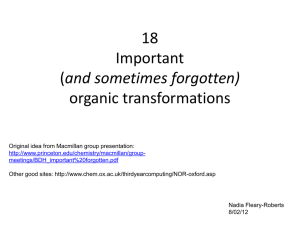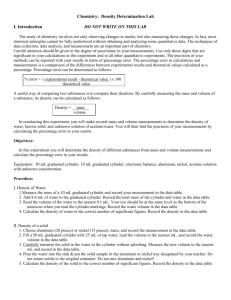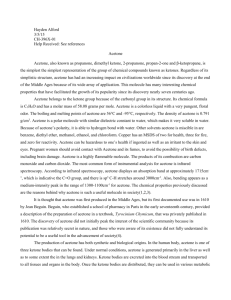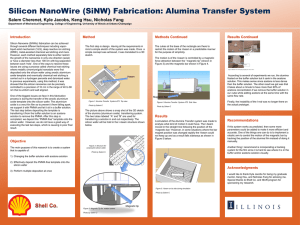WonfHorHii(revised) - Spiral
advertisement
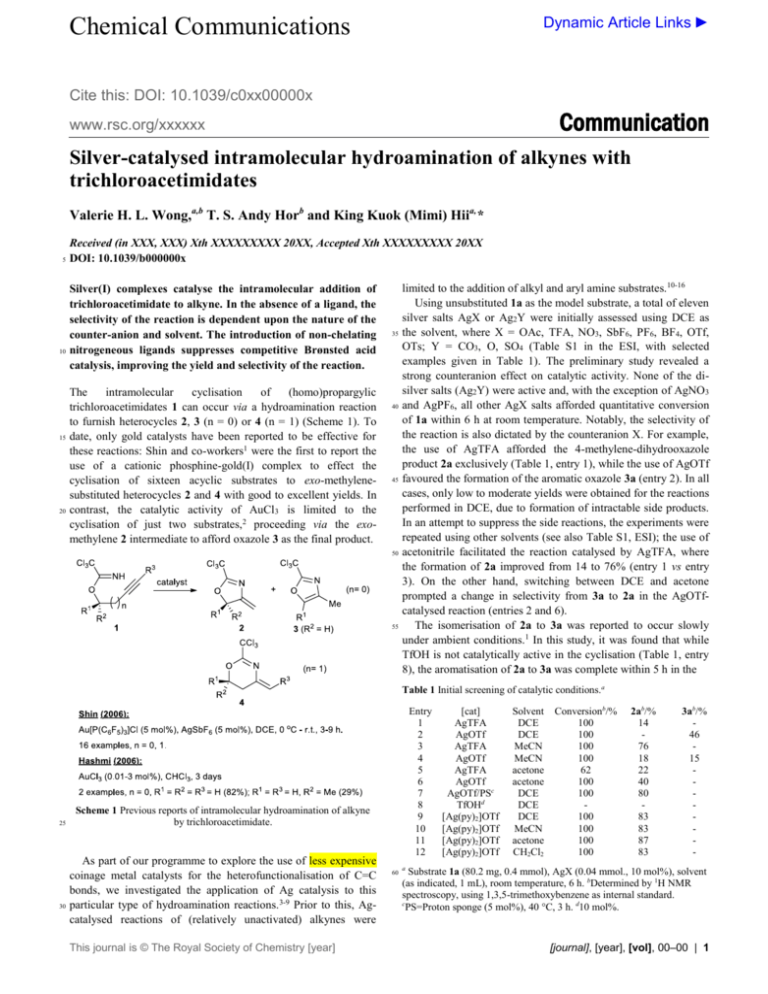
Dynamic Article Links ► Chemical Communications Cite this: DOI: 10.1039/c0xx00000x Communication www.rsc.org/xxxxxx Silver-catalysed intramolecular hydroamination of alkynes with trichloroacetimidates Valerie H. L. Wong,a,b T. S. Andy Horb and King Kuok (Mimi) Hiia,* 5 10 15 20 Received (in XXX, XXX) Xth XXXXXXXXX 20XX, Accepted Xth XXXXXXXXX 20XX DOI: 10.1039/b000000x Silver(I) complexes catalyse the intramolecular addition of trichloroacetimidate to alkyne. In the absence of a ligand, the selectivity of the reaction is dependent upon the nature of the counter-anion and solvent. The introduction of non-chelating nitrogeneous ligands suppresses competitive Brønsted acid catalysis, improving the yield and selectivity of the reaction. The intramolecular cyclisation of (homo)propargylic trichloroacetimidates 1 can occur via a hydroamination reaction to furnish heterocycles 2, 3 (n = 0) or 4 (n = 1) (Scheme 1). To date, only gold catalysts have been reported to be effective for these reactions: Shin and co-workers1 were the first to report the use of a cationic phosphine-gold(I) complex to effect the cyclisation of sixteen acyclic substrates to exo-methylenesubstituted heterocycles 2 and 4 with good to excellent yields. In contrast, the catalytic activity of AuCl3 is limited to the cyclisation of just two substrates,2 proceeding via the exomethylene 2 intermediate to afford oxazole 3 as the final product. 35 40 45 50 55 limited to the addition of alkyl and aryl amine substrates.10-16 Using unsubstituted 1a as the model substrate, a total of eleven silver salts AgX or Ag2Y were initially assessed using DCE as the solvent, where X = OAc, TFA, NO3, SbF6, PF6, BF4, OTf, OTs; Y = CO3, O, SO4 (Table S1 in the ESI, with selected examples given in Table 1). The preliminary study revealed a strong counteranion effect on catalytic activity. None of the disilver salts (Ag2Y) were active and, with the exception of AgNO 3 and AgPF6, all other AgX salts afforded quantitative conversion of 1a within 6 h at room temperature. Notably, the selectivity of the reaction is also dictated by the counteranion X. For example, the use of AgTFA afforded the 4-methylene-dihydrooxazole product 2a exclusively (Table 1, entry 1), while the use of AgOTf favoured the formation of the aromatic oxazole 3a (entry 2). In all cases, only low to moderate yields were obtained for the reactions performed in DCE, due to formation of intractable side products. In an attempt to suppress the side reactions, the experiments were repeated using other solvents (see also Table S1, ESI); the use of acetonitrile facilitated the reaction catalysed by AgTFA, where the formation of 2a improved from 14 to 76% (entry 1 vs entry 3). On the other hand, switching between DCE and acetone prompted a change in selectivity from 3a to 2a in the AgOTfcatalysed reaction (entries 2 and 6). The isomerisation of 2a to 3a was reported to occur slowly under ambient conditions.1 In this study, it was found that while TfOH is not catalytically active in the cyclisation (Table 1, entry 8), the aromatisation of 2a to 3a was complete within 5 h in the Table 1 Initial screening of catalytic conditions.a 25 30 Entry 1 2 3 4 5 6 7 8 9 10 11 12 Scheme 1 Previous reports of intramolecular hydroamination of alkyne by trichloroacetimidate. As part of our programme to explore the use of less expensive coinage metal catalysts for the heterofunctionalisation of C=C bonds, we investigated the application of Ag catalysis to this particular type of hydroamination reactions.3-9 Prior to this, Agcatalysed reactions of (relatively unactivated) alkynes were This journal is © The Royal Society of Chemistry [year] 60 [cat] AgTFA AgOTf AgTFA AgOTf AgTFA AgOTf AgOTf/PSc TfOHd [Ag(py)2]OTf [Ag(py)2]OTf [Ag(py)2]OTf [Ag(py)2]OTf Solvent DCE DCE MeCN MeCN acetone acetone DCE DCE DCE MeCN acetone CH2Cl2 Conversionb/% 100 100 100 100 62 100 100 100 100 100 100 2ab/% 14 76 18 22 40 80 83 83 87 83 3ab/% 46 15 - a Substrate 1a (80.2 mg, 0.4 mmol), AgX (0.04 mmol., 10 mol%), solvent (as indicated, 1 mL), room temperature, 6 h. bDetermined by 1H NMR spectroscopy, using 1,3,5-trimethoxybenzene as internal standard. c PS=Proton sponge (5 mol%), 40 °C, 3 h. d10 mol%. [journal], [year], [vol], 00–00 | 1 5 10 15 20 25 30 presence of 5 mol% of TfOH. With this in mind, the AgOTfcatalysed cyclisation of 1a was performed in the presence of a non-coordinating base (proton sponge), which afforded 2a exclusively with 80% conversion (entries 2 vs 7), showing that selective formation of the exo-methylene product 2 can be attained by Ag-catalysis, so long as the attendant Brønsted acidity can be suppressed. Guided by this, [Ag(py)2][OTf]17 was subsequently prepared and evaluated as a catalyst. Pleasingly, the use of the pyridine-ligated silver salt afforded 2a as the sole product. Furthermore, the catalyst is not only air- and moisturestable, but also readily soluble in a number of solvents, allowing consistently good results to be obtained across a number of different reaction media, with no deleterious effect on conversion or selectivity (Table 1, entries 9-12). The scope of the new catalyst was investigated with a number of substrates (Table 2), and the results were compared with those previously achieved using cationic gold complexes. With substrates containing alkyl substituents at the propargylic position (R1 and/or R2 = alkyl), very comparable results were attained using the silver catalyst at ambient temperature (entries 1-5). On the other hand, substrates 1 (where n = 0) containing aryl substituents at the propargylic position (R1 = Ar) or internal alkynes (R3 ≠ H) were reported to be inert towards gold catalysis.1 Thus, we were surprised to detect a low level of conversion in the cyclisation of the phenyl-substituted 1f to 2f (entry 6) at an elevated temperature of 60 °C. Even more pleasingly, good conversions can be obtained with substrates containing bromide and silyl substituents at the terminal alkyne position in good conversions18 (entries 7 and 8, respectively). In comparison, 6-exo-dig cyclisations with homopropargylic substrates (where n = 1) were equally facile at room temperature and the products can be isolated in good yields. Both alkyl and 40 45 50 55 Table 2 5- and 6-exo-dig cyclisations of (homo)propargylic trichloroacetimidates.a 60 35 Entry 1 2 3 4 5 6 7 8 9 10 11 12 13 14 15 16c R1, R2, R3 H, H, H Me, H, H Et, H, H i-Pr, H, H Me, Me, H H, H, Ph H, H, SiMe3 H, H, Br H, H, H Me, H, H Et, H, H Ph, H, H 4-ClC6H4, H, H 4-CF3C6H4, H, H H, H, Ph H, H, SiMe3 n 0 0 0 0 0 0 0 0 1 1 1 1 1 1 1 1 solvent acetone acetone acetone acetone acetone MeCN MeCN acetone acetone acetone acetone acetone acetone acetone acetone acetone T/°C 23 23 23 23 23 60 60 23 23 23 23 23 23 23 56 56 t/h 6 6 6 6 6 7 7 6 6 6 6 6 6 6 7 8 Product 2a 2b 2c 2d 2e 2f 2g 2h 4a 4b 4c 4d 4e 4f 4g 4h Yieldb 87 (67) 85 (74) >99 (86) 87 (82) 89 (79) 29 82 (72) 77 (30) 93 (76) 97 (93) 99 (91) 94 (90) 96 (87) 73 (70) 31 80 (71) 65 2 | Journal Name, [year], [vol], 00–00 Scheme 2 Proposed mechanisms leading to the observed stereoselectivity. The ability of one of the pyridine to dissociate from the metal during the reaction appears to be key to reactivity, as the reaction did not proceed when a chelating ligand was used, i.e. [(phen)Ag][OTf] (phen = phenanthroline, Table S1, ESI). Inherently, the dissociation of a pyridine is necessary to create a vacant coordination site for effective catalysis. In this case, we believe that the primary role of the liberated pyridine is to act as a Brønsted base to sequester triflic acid, thus preventing isomerisation to the aromatic heterocycles (3) and competitive side reactions, e.g. proto-desilylation of the silyl-substituted substrates and products. It may also have additional roles in the proton-transfer processes, as indicated in Scheme 2. Conclusions 70 75 a General reaction conditions: substrate 1 (0.4 mmol), [Ag(py)2][OTf] (0.04 mmol, 10 mol%), solvent (1 mL). bDetermined by 1H NMR spectroscopy, using 1,3,5-trimethoxybenzene as internal standard. Isolated yields are indicated in parenthesis. c20 mol% catalyst used. aryl substituents can be accommodated at R1 (Table 2, entries 914). Once again, conversions of internal alkyne substrates 1g and 1h were slow, which can be improved by increasing catalyst loading (entries 15 and 16). The ability of the silver catalyst to promote reactions with internal alkynes is particularly noteworthy. It also provides a means of establishing the stereochemical pathway of the addition step. The products were obtained as the Z-isomer exclusively, determined by NOE experiments performed on the trimethylsilylsubstituted product 4h (ESI). This is commensurate with a mechanism whereby the addition of the N-H bond occurs in an exo-metallic fashion to a -coordinated alkyne (Scheme 2). The putative (vinyl)silver complex then undergoes a protonolysis to afford an overall anti-addition across the C≡C bond. The silver-catalysed intramolecular hydroamination addition of trichloroacetimidate to alkyne has been achieved for the first time, whereby the nature of the counteranion, solvent and ligand were found to have profound effects on catalytic turnover and selectivity. Encouragingly, the [Ag(py)2][OTf] complex is found to be highly effective for the cyclisation of internal alkynes to afford vinyl-bromide and silane products, which had not been possible using gold catalysts. The potential applications of these intermediates for organic synthesis (e.g. via cross coupling chemistry) is currently being investigated, and will be reported in due course. 80 This journal is © The Royal Society of Chemistry [year] We thank the National University of Singapore for a Research Scholarship to VHLW. Notes and references a 5 10 15 20 25 30 35 40 Department of Chemistry, Imperial College London, Exhibition Road, South Kensington, London SW7 2AZ, U.K; E-mail: mimi.hii@imperial.ac.uk b Department of Chemistry, National University of Singapore, 3 Science Drive 3, Singapore 117543. † Electronic Supplementary Information (ESI) available: Experimental procedures, extensive optimisation tables and copies of 1H and 13C NMR spectra. See DOI: 10.1039/b000000x/ 1. J. E. Kang, H. B. Kim, J. W. Lee and S. Shin, Org. Lett., 2006, 8, 3537-3540. 2. A. S. K. Hashmi, M. Rudolph, S. Schymura, J. Visus and W. Frey, Eur. J. Org. Chem., 2006, 4905-4909. 3. J. G. Taylor, N. Whittall and K. K. M. Hii, Chem. Commun., 2005, 5103-5105. 4. J. G. Taylor, N. Whittall and K. K. Hii, Org. Lett., 2006, 8, 35613564. 5. L. A. Adrio and K. K. Hii, Chem. Commun., 2008, 2325-2327. 6. L. A. Adrio, L. S. Quek, J. G. Taylor and K. K. Hii, Tetrahedron, 2009, 65, 10334-10338. 7. J. L. Arbour, H. S. Rzepa, A. J. P. White and K. K. Hii, Chem. Commun., 2009, 7125-7127. 8. L. A. Adrio and K. K. Hii, Eur. J. Org. Chem., 2011, 1852-1857. 9. J. L. Arbour, H. S. Rzepa, J. Contreras-Garcia, L. A. Adrio, E. M. Barreiro and K. K. Hii, Chem—Eur. J., 2012, 18, 11317-11324. 10. Y. M. Luo, Z. G. Li and C. J. Li, Org. Lett., 2005, 7, 2675-2678. 11. J. Sun and S. A. Kozmin, Angew. Chem. Int. Ed., 2006, 45, 49914993. 12. N. Lingaiah, N. S. Babu, K. M. Reddy, P. S. S. Prasad and I. Suryanarayana, Chem. Commun., 2007, 278-279. 13. J. M. Carney, P. J. Donoghue, W. M. Wuest, O. Wiest and P. Helquist, Org. Lett., 2008, 10, 3903-3906. 14. H. Li, C. Wang, H. Huang, X. Xu and Y. Li, Tetrahedron Lett., 2011, 52, 1108-1111. 15. X. Zhang, Y. Zhou, H. Wang, D. Guo, D. Ye, Y. Xu, H. Jiang and H. Liu, Green Chem., 2011, 13, 397-405. 16. Y. Liu, G. Wu and Y. Cui, Appl. Organomet. Chem., 2013, 27, 206208. 17. C. Di Nicola, Effendy, F. Marchetti, C. Nervi, C. Pettinari, W. T. Robinson, A. N. Sobolev and A. H. White, Dalton Trans., 2010, 39, 908-922. 18. The bromo-product 2h decomposes during the isolation procedure. 45 This journal is © The Royal Society of Chemistry [year] Journal Name, [year], [vol], 00–00 | 3


